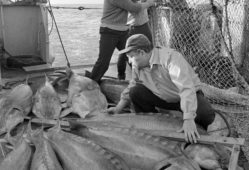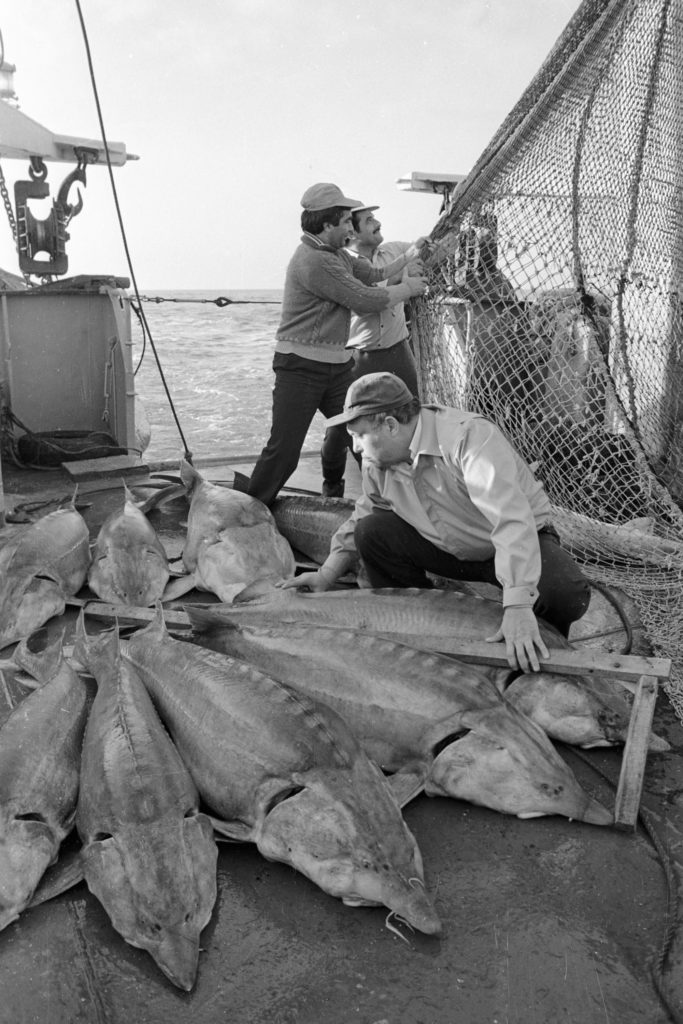BAKU
By LADA YEVGRASHINA
Azerbaijan, the ancestor of oil production at sea, is renowned worldwide for another black gold: caviar.
Traditionally taken from sturgeon, it’s a Caspian delicacy which, since it became popular in the 17th century, has been known worldwide as a luxury product, supplied to Europe’s royal courts, Michelin-starred restaurants and fishmongers. But overfishing, and lack of regulation, brought it to the brink of disappearing.
The Caspian was the world’s largest reservoir for the replenishment of sturgeon, the oldest large fish species. Until the end of the 20th century, sturgeons caught in this reservoir accounted for up to 90 percent of the world’s sturgeon catch. The prized roe, cured with salt, traditionally comes from three sturgeon species- sturgeon, beluga and starred sturgeon.
Sturgeon eggs are laid on sections of rivers with a rocky bottom and a fast current. Caspian sturgeon rush to the Volga to spawn, to the Samur, Kura, Araks, Terek, and Ural rivers. It’s a slow process: the female Volga sturgeon only reach sexual maturity between the age of 13 and 18, with one fish producing on average 300,000 eggs in its lifetime, with the largest capable of producing up to 800,000.
But like many of the world’s fish, its population suffered drastic declines. In the early 20th century, as much as 40,000 tonnes a year of sturgeon were caught in the Caspian basin. In Soviet times, numbers held up even in the 1970s, when annual catches of 30,000 tonnes were recorded. For the Soviet Union, caviar was a lucrative commodity, and sturgeon fishing was regulated.
In the 1980 and even through to the 1990s, the total production of black caviar worldwide reached 1,000 tonnes per year.
Seventy-year old Baku resident Lyudmila Meltser remembers that even in the 1990s, a kilo of sturgeon meat could be bought in capital’s markets for between 5 to 10 roubles, and a 600-gram can of black caviar for 10 to 15 roubles, around the same price as a packet of Chesterfield cigarettes. It was an affordable delicacy: the salary of an engineer at that time was between 150 to 200 roubles. Azerbaijan’s residents frequently had a can of caviar in their fridge.
The Soviet Union’s collapse, putting an end to fishing regulations, soon sent sturgeon stocks went into sharp decline. The corruption and lawlessness reigned in this industry allowed state-owned companies and ordinary fishers to catch sturgeon for their meat and their black caviar uncontrollably. The Caspian’s sturgeon population came perilously close to dying out.
The turning point came with the beginning of the 21st century when Caspian countries formally recognised this threat. The Caspian sturgeon was listed on the International Union for Conservation of Nature (IUCN)’s Red List. According to the IUCN, 63 percent are listed as Critically Endangered, the Red List’s highest threat category. Four species are now possibly extinct.

Measures followed to try and stop the sturgeon population’s decline. Since 1998, the Convention on International Trade in Endangered Species (CITES) has regulated the sturgeon and caviar trade. By 2020, the total production of caviar in the world dropped to 300 tonnes. Supply chains now require strict documentation charting the journey of a can of caviar from farm to consumer, as well as labelling indicating type, country of origin, and year of harvest.
In Russia, commercial fishing of beluga in the Volga-Caspian basin has been banned since 2000, and sturgeon and stellate sturgeon since 2005. By 2011-14, the same measures were introduced in Azerbaijan, Kazakhstan, Iran and Turkmenistan. In 2014, at the summit of the Caspian states, a unanimous decision was taken to ban large-scale fishing of sturgeon, a moratorium that is extended every year. Individual countries now report on which actions they have taken to release sturgeon fry to replenish the population and set quotas for sturgeon fishing and black caviar production.
But for the wild sturgeon population, the damage was already done. Farida Alekperova, a representative of the Ministry of Ecology and Natural Resources of Azerbaijan, said that sturgeon numbers in the Caspian had decreased almost tenfold since the 1990s. Currently, Alekperova said, the only way to preserve their natural populations is through artificial reproduction at sturgeon fish hatcheries and the release of fry into natural reservoirs.
In the Caspian basin, four Azerbaijani fish farms engage in the artificial reproduction of sturgeon, but in the Russian Federation and Iran. These four hatcheries, operating in Khilli, Shirvan, Kura and Ust-Kura, annually release about 8-9 million fry into the Caspian Sea. In total, since 2001, Azerbaijan has released 190 million sturgeon fry into the Caspian Sea.
For Azerbaijan’s residents, the era of affordable caviar is long over. A 113-gram jar of black caviar in Baku will set you back at least $100. No more than 250 grams of black caviar per person can be exported from Azerbaijan. It’s now a heavily regulated luxury sold only in specialized stores. It’s even rarer abroad: the U.S. stopped imports of beluga caviar from the Caspian in 2005 due to fears that overfishing was driving the species to near extinction.
In the caviar boutique Baku Caviar, situated in the old fortress near the Maiden Tower, staff tell the Tribune that the official caviar production in Azerbaijan dates back to 1954 when the first sturgeon breeding plant was built in the Neftechala region of the country.
“In Soviet times, this caviar was supplied to the Kremlin, and one of the most famous admirers of this particular caviar was Sir Winston Churchill,” an employee of Baku Caviar said.
Caviar still has its place in politics. Black caviar is still used by some officials Caspian as an effective bribe for foreign politicians, a process Westerners soon coined “caviar diplomacy.”
With farmed caviar gaining in popularity, a new player such as China soon dominated both production and consumption. According to the European Fisheries and Aquaculture Marketing Observatory report, Chinese fish farmers already export 150 tonnes of caviar per year, a rapid growth that’s intensified international competition over the past decade. Chinese company Kaluga Queen is now the largest caviar producer globally, responsible for one-third of world caviar production.
For the Caspian, the golden age of caviar has long passed.

